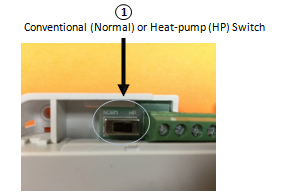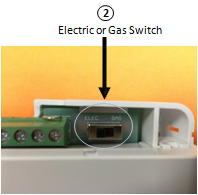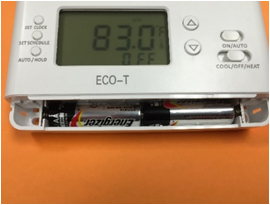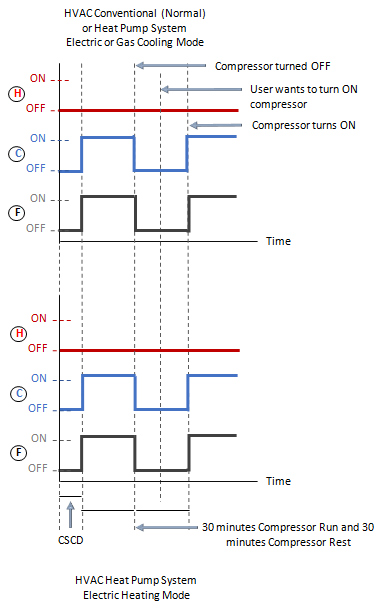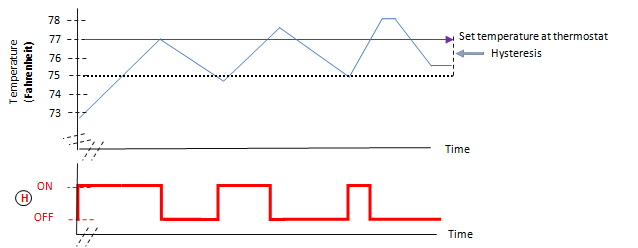Thermostat Settings
Below is a typical thermostat with electric or gas settings. Note that it can be used for Conventional (normal) or Heat-pump HVAC systems. This manual uses this type of thermostat as reference (functions and features in thermostats vary by type).
Note : The fan, when set to ON, will be running indefinitely regardless if the thermostat is set to Cool, OFF, or heat mode. The fan will automatically turn ON and OFF in cool or heat mode as required by the thermostat.
Thermostat Control Over Compressor Behavior (Short Cycle Protection Delay)
Thermostats often apply a short cycle protection delay, every time the compressor is turned OFF (regardless if selecting cool or heat mode requires compressor use). The delay protects the compressor from turning ON and OFF in a continuous short period of time. This delay varies by system. In some systems if the compressor has been OFF for more than the time the delay takes, the delay will not happen when the system requires to turn it ON again. It rested enough time to be used immediately.
In this manual, the delay is also referred as a compressor short cycle delay (CSCD). It will be considered to last up to 5 minutes.
Example:
The compressor is used for 10 minutes by the HVAC system to lower the temperature in a room. The HVAC system is turned OFF once the selected room temperature set at the thermostat has reached, or if the user turns the system OFF at the thermostat.
– If a few seconds have passed and the user, or the thermostat requires the HVAC system to lower the temperature in the room again:
The thermostat will wait 5 minutes to complete the delay time. After these 5 minutes, the compressor and fan will turn ON to provide cool air.
– Similarly if 2 minutes have passed and the user, or the thermostat requires the HVAC system to lower the temperature in the room again:
The thermostat will wait 3 minutes to complete the delay time. After the 3 minutes, the compressor and fan turn ON to provide cool air.
The top graph displays signal behavior during cool mode. The bottom graph displays signal behavior during heat mode (when compressor usage is required).
Signals from Thermostat to HVAC system:
— Compressor signal (C)
— Fan signal (F)
— Heater signal (H)
Note: When the compressor is turned ON, the Fan will always be ON. In Heat Pump systems, the compressor provides heat or cool (depending on selected settings).
CSCD: Compressor short cycle delay of 5 minutes
Thermostat Control Over Compressor Behavior (Compressor Rest)
Thermostats may also apply a compressor rest every time the compressor is turned ON for a particular period of time (regardless of selecting cool or heat mode). This rest refers to turning OFF the compressor as per HVAC system duty cycle specifications.
This rest time varies by system.
In the following example, compressor run and compressor rest time will be considered 30 minutes (50% duty cycle).
Example:
The compressor is used for 30 minutes by the HVAC system to lower the temperature in a room. The compressor will rest (be turned OFF) for 30 minutes.
The top graph displays signal behavior during cool mode.
The bottom graph displays signal behavior during heat mode (when compressor usage is required).
NOTE: A short cycle protection delay can occur during a compressor rest time. The time it takes for the compressor to turn ON will depend on which of the delays is the longest.
Signals from Thermostat to HVAC system:
— Compressor signal (C)
— Fan signal (F)
— Heater signal (H)
Note: When the compressor is turned ON, the Fan will always be ON. In Heat Pump systems, the compressor provides heat or cool (depending on selected settings).
CSCD: Compressor short cycle delay of 5 minutes
Thermostat Control and Hysteresis
Most thermostats come with a predefined hysteresis. Typically adjustments can be made to a thermostat’s hysteresis. Hysteresis in a thermostat helps protect the HVAC system it is connected to. It accommodates a range of temperature for the thermostat to send turn ON or turn OFF signals to an HVAC system. This is done to avoid turning it ON and OFF in a continuous short period of time.
Hysteresis in Cool Mode
Example 1:
The thermostat is set up to maintain a room as low as 75° Fahrenheit. Hysteresis is adjusted to 2°. This means that at any temperature higher than or equal to 75° + 2° Fahrenheit the compressor should turn ON (Provided it has finished its short cycle protection delay or rest time).
The thermostat would signal the HVAC system to turn the compressor OFF once it reaches 75° Fahrenheit.
Based on external conditions, temperature in the room may lower or rise afterwards.
If temperature in the room varies between 75° and 77° Fahrenheit, the compressor will not turn ON until it reaches 77° Fahrenheit or a higher temperature.
If hysteresis were of smaller value, the compressor would be signaled to turn ON and OFF in a brief period time. Although protected by short cycle delay or a rest, if this were to be continuous it could render the system to malfunctions over time.
Some thermostat may force a compressor to run for a definite amount of time. Hysteresis application may also vary by system.
Hysteresis in Heat Mode (Using the Compressor)
Example 2:
The thermostat is set up to maintain a room as high as 77° Fahrenheit. Hysteresis is adjusted to 2°. This means that at any temperature lower than or equal to 77° – 2° Fahrenheit the compressor should turn ON (Provided it has finished its short cycle protection delay or rest time).
The thermostat would signal the HVAC system to turn the compressor OFF once it reaches 77° Fahrenheit.
Based on external conditions, temperature in the room may lower or rise afterwards.
If temperature in the room varies between 75° and 77° Fahrenheit, the compressor will not turn ON until it reaches 75° Fahrenheit or a lower temperature.
If hysteresis were of smaller value, the compressor would be signaled to turn ON and OFF in a brief period time. Although protected by short cycle delay or a rest, if this were to be continuous it could render the system to malfunctions over time.
Some thermostat may force a compressor to run for a definite amount of time. Hysteresis application may also vary by system.
Hysteresis may apply in the same way to both an electric heater in conventional (normal) HVAC systems and the compressor in a heat-pump HVAC system.
Hysteresis in Heat Mode (No Compressor Use)
Example 3:
The thermostat is set up to maintain a room as high as 77° Fahrenheit. Hysteresis is adjusted to 2°. This means that at any temperature lower than or equal to 77° – 2° Fahrenheit the compressor should turn ON (Provided it has finished its short cycle protection delay or rest time).
The thermostat would signal the HVAC system to turn the compressor OFF once it reaches 77° Fahrenheit.
Based on external conditions, temperature in the room may lower or rise afterwards.
If temperature in the room varies between 75° and 77° Fahrenheit, the compressor will not turn ON until it reaches 75° Fahrenheit or a lower temperature.
If hysteresis were of smaller value, the compressor would be signaled to turn ON and OFF in a brief period time. Although protected by short cycle delay or a rest, if this were to be continuous it could render the system to malfunctions over time.
Some thermostat may force a heater to run for a definite amount of time. Hysteresis application may also vary by system.
Hysteresis may apply in the same way to both an electric heater in conventional (normal) HVAC systems and the compressor in a heat-pump HVAC system.


